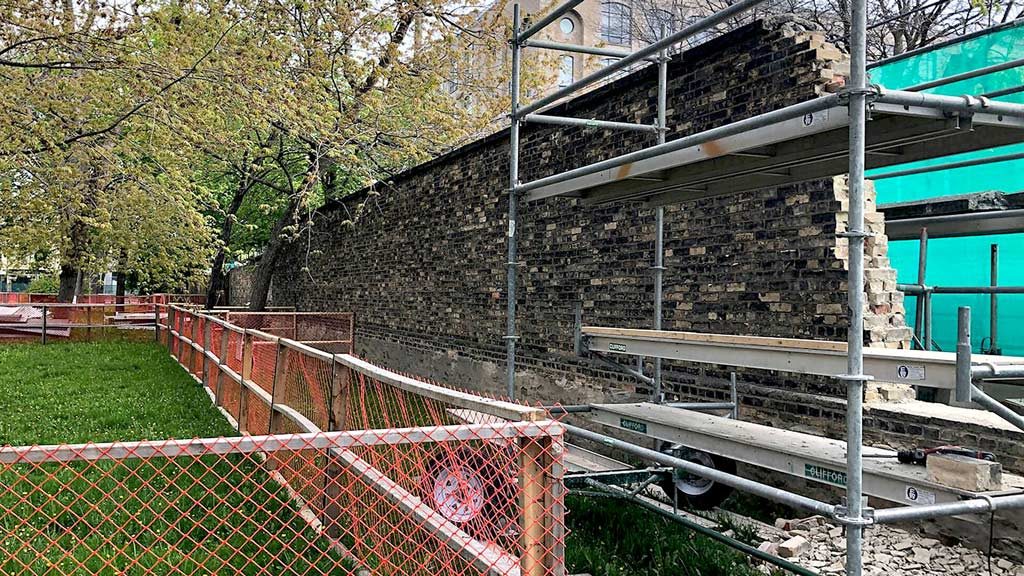Work continues on restoring a section of the heritage wall that marks part of the eastern boundary of the Centre for Addiction and Mental Health (CAMH) in Toronto.
It’s part of the CAMH’s Queen Street Redevelopment Project, which aims to integrate the facility with the surrounding neighbourhood. The plaques that mark the wall tell an important story about their construction. It’s not a history of contractors and their employees, but about patients toiling without compensation to build the walls that separated them from the community.
The construction of Ontario’s Provincial Lunatic Asylum in Toronto was completed in 1850 with all the good intentions of a great public project. Commentary in the January 31, 1850 issue of the Globe newspaper notes: “The erection, then of such an edifice as we have described is honourable in the foresight, and charity of its rulers — it is a monument to the Christian liberality of the People.”
Honourable intentions, however, soon gave way to unpleasant realities, such as overcrowding, unhealthy conditions and abuse of patients.
A therapeutic program designed to provide meaningful vocational tasks for patients turned instead into a program that cut operating costs for the institution by forcing them to perform a wide variety of unpaid labour. The construction of the brick-and-mortar walls that surround the facility were part of that program. The inscriptions by patients over more than 150 years can still be found on the faces of the wall’s bricks and stones.
The wall no longer encloses the facility and portions of it have been moved and rebuilt over the years. What remains is designated under the Ontario Heritage Act. The current restoration project, awarded to Clifford Restoration Limited, involves the removal of a small portion of the northeast wall that will allow greater roadway access into the grounds. The best elements of that section will be used to help restore the remainder of the northeast wall.
The wall is made up of three wythes of common clay bricks, likely produced at the Don Valley brickworks. Damage to the wall includes spalling, water damage, erosion, cracks, ivy scars, and rust and copper staining.
But a significant degree of damage was caused by the use of relatively soft brick and cement-rich hard mortar that was likely used in subsequent repointing of the wall.
“The primary reason hard mortar accelerates decay is that it traps moisture within the wall,” says Phil Puype, vice-president at Clifford.
“The moisture that is absorbed or enters the wall through cracks and openings that used to move out through the lime-based mortar is now trapped within the wall and is forced to go out through the softer more permeable brick units. That can lead to their saturation and mechanical damage during freeze-thaw cycles.”
Dense cement-rich mortars also lack the flexibility of lime-based mortars, so they can’t easily accommodate the movements of the structure due to moisture and fluctuations in temperature. That creates stresses near the face of the brickwork and causes additional mechanical damage. Hard mortars also tend to de-bond and crack, leading to moisture entering the structure through capillary action.
“The goal of the rehabilitation is to restore and stabilize the wall into a serviceable condition and remove some of the deterioration factors, such as cracks, holes, damaged bricks and mortar,” says Puype. “That will create a condition where the wall can resist weathering going forward while retaining as much of the original historic fabric as is possible.”
Replacement of the cement-based mortar with more appropriate hydraulic lime-based mortar and replacement of damaged bricks should slow, if not arrest, much of the deterioration of the wall.
“Our intent is to create a rebuilt and repointed wall that is structurally sound and allows moisture to move freely in and out, so it’s not being trapped within the wall and deteriorating the bricks,” says Puype.
CAMH anticipates that the wall restoration project will be completed in October.
Part of the inscription on a historic plaque erected near the wall reads: “Seen by many as the physical representation of prejudiced attitudes towards people with a psychiatric diagnosis, the walls which still stand today are historical monuments to the exploited labour of psychiatric patients who lived, work and died on these grounds since 1850.”
The current restoration work will ensure that this history is never forgotten.











Recent Comments
comments for this post are closed